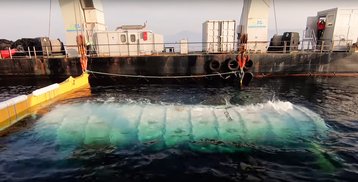A proposed plan to revive a tidal lagoon project in Swansea Bay, Wales, and build a floating island could include an underwater data center.
Much remains still to be decided: Whether 'Dragon Energy Island' will go ahead, what it will include, and how large a data center deployment would be.
Not the energy drink
Back in 2015, a lagoon renovation bid by Tidal Lagoon Power gained planning consent but ultimately failed to gain UK Government funding. "This was purely an energy project," Paul Marsh, Holistic Capital's CEO told DCD.
A Swansea Bay City Region task force commissioned Marsh's company to provide a report on a new approach to the lagoon, expanding the project beyond just energy. The report, some of which has been made public, includes a floating modular housing development (with up to 10,000 homes), an underwater data center, solar farm and the production of pure hydrogen and pure oxygen on site for storage or sale.
"At this stage we are presenting a range of options that may be possible to take the project forward, and we considered that the potential for a data center was relevant due to the relatively close proximity of Oxwich Bay," Marsh told DCD. Oxwich Bay is home to the landing stations for several submarine cables, including the Solas cable, the Swansea-Brean cable and the defunct TAT-11 and Gemini North transatlantic telephone cables.
The report (available to download here) said: "The Dragon Energy Island Project represents a completely new approach, to build upon the natural tidal energy production opportunity in Swansea, as well as delivering a world leading integrated renewable energy hub in Swansea Bay.
"The Welsh Government was the first parliament in the world to declare a Climate Emergency and the Dragon Energy Island project has enormous potential for the Welsh Government to lead the way, and to address these critical global concerns with positive action."
The review recommends that the City Region, supported by Welsh Government, works with a private sector partner - perhaps on the basis of joint investment - "without the need for subsidy."
Rob Stewart, Swansea Council Leader and chairman of the City Region's task force, said: "Despite the UK Government not backing the previous proposals, we never gave up hope on the opportunity to deliver a major renewables project in Swansea Bay.
"An enormous amount of hard work has taken place behind the scenes to develop a new proposal that will generate clean, green power for many generations to come.
"The new proposal is a larger and more ambitious renewable energy development that's built upon the natural tidal benefits of Swansea Bay and complimentary technology to generate zero-carbon power."
The next step is for the Swansea Bay City Region's Joint Committee to consider the report, although no date has been publicly set for a decision to be made. Should it go ahead, construction could start in 2021, with the Dragon Energy Island potentially operational by the end of 2026.
"There's considerable interest from major companies in turning this opportunity into a commercial reality, so we're now keen to move forward," Stewart said.
Dunking data centers
Faced with enormous cooling costs and environmental concerns, the concept of underwater data centers is one the industry has explored for some time, with Microsoft's Project Natick first surfacing [Ahem...] as a white paper in 2013.
In 2016, Microsoft then ran a three month test off of the US Pacific coast, with the ’Leona Philpot’ (named after a character from the Xbox’s Halo) featuring one server rack in an eight-foot (2.4m) diameter cylinder filled with unreactive nitrogen gas.
Two years later, Microsoft submerged a 12-rack cylinder off of the coast of the Orkney Islands, Scotland.
Nautilus, meanwhile, hopes to take advantage of large bodies of water without going under them. The company, which develops data centers on barges, is aiming to build its first commercial deployment in Limerick, Ireland - but is facing local opposition.
These options remain fringe ideas, however. Overwhelmingly, the industry has yet to take the plunge.




